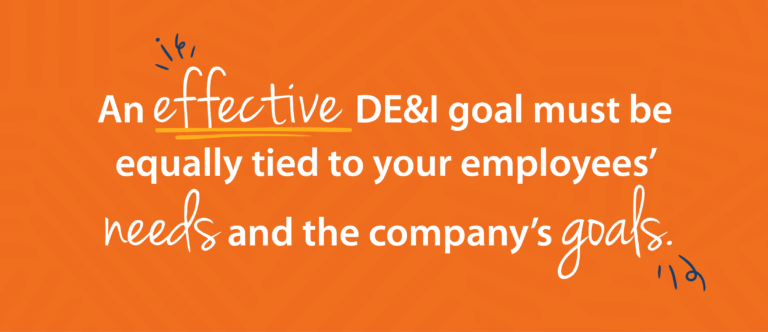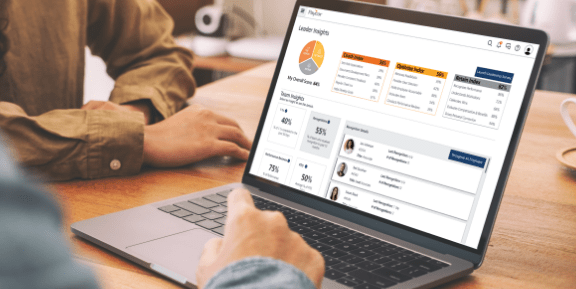Best practices for diversity, equity, and inclusion in the workplace are constantly evolving. Just like best practices for sales, marketing, and customer service, leaders need to stay current if they want to be competitive. However, DE&I is unique among these issues because it centers on the hearts, minds, and personal identities of everyone on your team.
Defining DE&I
Your DE&I strategy has a direct impact on company culture. It affects employee engagement, job satisfaction, retention rates, and more. While DE&I is complex and far-reaching in practice, the fundamental ideas behind it are easy to understand:
Diversity is a noun. Harvard University defines diversity as “being different or having differences” specifically among people. It’s an accurate way to describe identity, acknowledging that everyone is unique.
Equity, in a work context, means ensuring everyone can access the resources they need to be successful, despite any potential barriers related to their identities and experiences. Those resources could include on-the-job training, sponsorship, mandatory benefits, visibility within the company, and so on.
It’s important to note the difference between equity and equality. Equality gives everyone the same access to resources with a one-size-fits-all approach, while equity accounts for each person’s unique needs. As the Peace Corps explains: Equality means giving everyone the same pair of shoes; equity means giving everyone a pair of shoes that fits.
Inclusion is an active process. It doesn’t happen automatically. In an inclusive environment, everyone feels safe enough to express their identity, trusting they’ll be accepted for who they are. Creating an inclusive workplace is an ongoing effort because certain aspects of identity change over time, like age or whether someone is a parent. Making your team feel included can start small – it could be as simple as expressing empathy for a new mom who continues to work full-time while caring for an infant.
Why DE&I Drives Results
DE&I is a necessary component of employee engagement and company culture. For many businesses, like Paycor, it also directly impacts financial outcomes. Our DE&I team works closely with our sales team, providing support as sellers build and bolster relationships with customers. Many potential customers ask for direct access to the DE&I team to ensure that our DE&I values align with what is important to them.
Paycor isn’t the only business to profit from prioritizing DE&I. Studies consistently show companies with more diverse leadership outperform their competitors (LinkedIn). Diverse teams also tend to be more innovative, better at problem-solving, and more capable of capturing new markets.
The Changing Landscape of DE&I
In today’s political, legal, and social climate, the role of DE&I in business is facing criticism. HR can no longer justify DE&I goals as simply “the right thing to do” – even when they are. Instead, leaders need to position DE&I efforts as a functional aspect of the organization, tying specific goals to the company’s bottom line.
Most businesses are maintaining their commitment to DE&I (Seramount) but updating the details of their strategies. HR teams are a vital part of this shift. Now more than ever, HR is a strategic partner to the C-suite, supporting its efforts in terms of budget, talent, and overall business strategy. DE&I leaders need to be steadfast through this era of change, ensuring the organization’s HR strategy stays aligned with its larger cultural and business goals.
Designing a DE&I Strategy
DE&I exists in the context of your overarching business strategy. If you want to set and achieve effective DE&I goals, you need to understand the big picture. Start by answering these questions:
- What are your business’s current Objectives and Key Results (OKRs)?
- What specific actions are executives taking to reach short- and long-term business goals?
- Why is it important for your business to integrate DE&I into the company’s goals?
- What impact will a comprehensive DE&I strategy have on the people in the business?
- What are your company’s core values? Does your culture align with them?
- Consider your business’s community. It includes your customers, partners, shareholders, team members, their families, and more. If you have a brick-and-mortar business, it could even include other storefronts on the same block. How do the people in this wider community impact your company’s growth?
Don’t stop there – write your own list of questions, ask the people in your business what their needs are, and then let your answers inform your strategy. Now more than ever, HR has to think holistically. Gone are the days of people leaving their personal lives at home. Today’s employees don’t just want work/life balance; they’re calling out for work/life integration (U.S. Chamber of Commerce). HR can help them achieve it by creating a thoughtful strategy that accounts for their needs, strengths, and career goals, not just the company’s success.
Setting Effective DE&I Goals
Once you have a sense of the big picture, it’s time to break down your strategy into specific, manageable goals. I recommend using the SMART framework to communicate your vision. In that model, goals should be:
Specific: Clearly state the desired outcome.
Measurable: Include guidelines for measuring your success, including how you’ll collect data.
Achievable: Make sure your goals are realistic given the team’s capacity.
Relevant: When every smaller goal supports the same vision, it’s easier to keep your team on track.
Time-bound: Every goal should have an end date to promote accountability.
The SMART model can help you set goals in any area of business, but DE&I goals are a little different.

Employees don’t need empty promises; they need to see leaders respond to their feedback in real time. If you fail to prioritize your people, they’ll stop trusting your vision – and your retention rate will suffer.
Examples of DE&I Goals
Whether you’re bracing for change or embracing it, leaders need to prepare for whatever this year will bring. To meet the moment, find ways to integrate DE&I into every aspect of your HR strategy. For example:
Recruiting
Communicate your DE&I goals widely. Sharing your values with the public can help HR widen the talent pool, especially when it comes to the next generation of workers. Research shows Gen Z values diversity at work more than previous generations (Johns Hopkins University). If you want to attract these valuable job candidates, demonstrate the integration of DE&I into the fabric of your business.
Talent Development
Retain, upskill, and promote top talent. In the past, DE&I strategies focused on increasing diversity through recruiting and hiring practices. This should continue to be a goal for HR, but we’re also amid an ongoing talent shortage. Leaders need to focus more on retaining, upskilling, and promoting their already diverse teams.
On a practical level, that means ensuring your promotion process goes beyond equality and strives for equity. You don’t have to choose between a diverse team and a talented one. Instead, you can ensure that everyone at your company has access to mentoring and sponsorship opportunities so they’ll be well-positioned for career growth when new positions become available.
Employee Engagement
Drive employee engagement through Employee Resource Groups (ERGs). HR may set the tone for company culture, but your employees need to play an active role, too. ERGs empower workers to build relationships with people who share their identities, interests, or values. Members support each other professionally and personally, sharing resources and career opportunities. DE&I leaders can also use these groups as a resource, turning them for guidance on what types of support employees need most.
Achieving Your DE&I Goals
Once you set integrated DE&I goals, how will you achieve them? Your company needs the right tools to support this ongoing progress. Make sure your HR software can support processes like:
- Optimizing your talent pipelines: Recruiting tools help HR attract a more diverse talent pool.
- Analyzing DE&I Metrics: Data without insight is just noise. Analytics software provides actionable insights into HR metrics so you can measure your progress toward DE&I goals.
- Helping you stay compliant: Like inclusion, compliance is an ongoing process. HR needs tools that track changing laws and help you update your workflows accordingly. Whether you’re keeping up with pay equity rules or fair hiring practices, this process is an essential part of DE&I.
Paycor’s tools empower leaders to reach their DE&I goals. Connect with our team or take a product tour to learn more.










